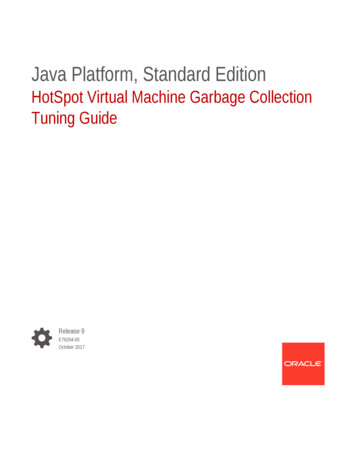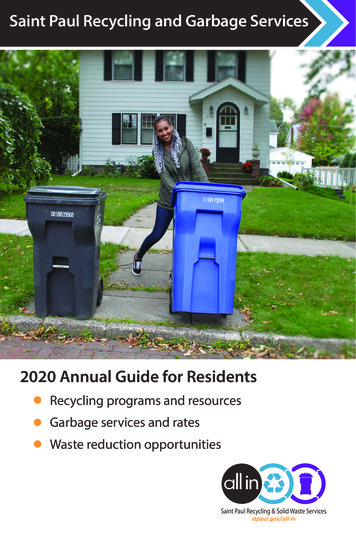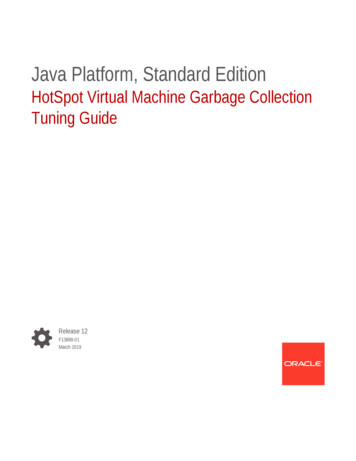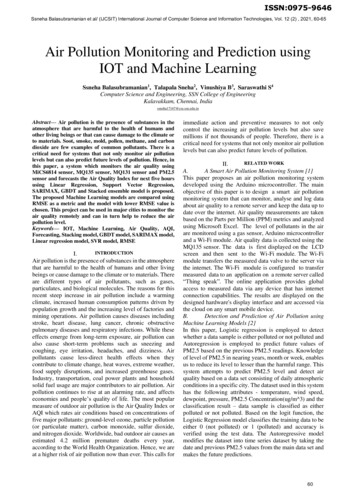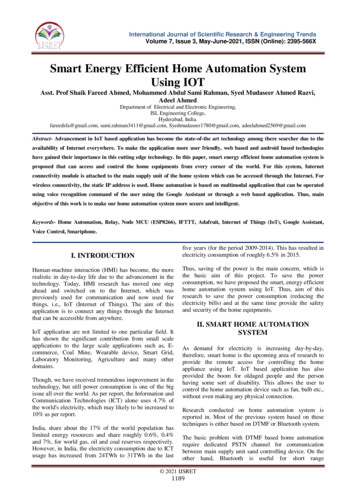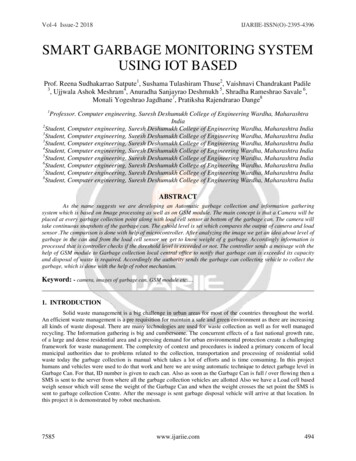
Transcription
Vol-4 Issue-2 2018IJARIIE-ISSN(O)-2395-4396SMART GARBAGE MONITORING SYSTEMUSING IOT BASEDProf. Reena Sudhakarrao Satpute1, Sushama Tulashiram Thuse2, Vaishnavi Chandrakant Padile3, Ujjwala Ashok Meshram4, Anuradha Sanjayrao Deshmukh 5, Shradha Rameshrao Savale 6,Monali Yogeshrao Jagdhane7, Pratiksha Rajendrarao Dange81Professor. Computer engineering, Suresh Deshumukh College of Engineering Wardha, MaharashtraIndia2Student, Computer engineering, Suresh Deshumukh College of Engineering Wardha, Maharashtra India3Student, Computer engineering, Suresh Deshumukh College of Engineering Wardha, Maharashtra India3Student, Computer engineering, Suresh Deshumukh College of Engineering Wardha, Maharashtra India4Student, Computer engineering, Suresh Deshumukh College of Engineering Wardha, Maharashtra India5Student, Computer engineering, Suresh Deshumukh College of Engineering Wardha, Maharashtra India6Student, Computer engineering, Suresh Deshumukh College of Engineering Wardha, Maharashtra India7Student, Computer engineering, Suresh Deshumukh College of Engineering Wardha, Maharashtra India8Student, Computer engineering, Suresh Deshumukh College of Engineering Wardha, Maharashtra IndiaABSTRACTAs the name suggests we are developing an Automatic garbage collection and information gatheringsystem which is based on Image processing as well as on GSM module. The main concept is that a Camera will beplaced at every garbage collection point along with load cell sensor at bottom of the garbage can. The camera willtake continuous snapshots of the garbage can. The eshold level is set which compares the output of camera and loadsensor .The comparison is done with help of microcontroller. After analyzing the image we get an idea about level ofgarbage in the can and from the load cell sensor we get to know weight of g garbage. Accordingly information isprocessed that is controller checks if the threshold level is exceeded or not. The controller sends a message with thehelp of GSM module to Garbage collection local central office to notify that garbage can is exceeded its capacityand disposal of waste is required. Accordingly the authority sends the garbage can collecting vehicle to collect thegarbage, which is done with the help of robot mechanism.Keyword: - camera, images of garbage can, GSM module etc .1. INTRODUCTIONSolid waste management is a big challenge in urban areas for most of the countries throughout the world.An efficient waste management is a pre requisition for maintain a safe and green environment as there are increasingall kinds of waste disposal. There are many technologies are used for waste collection as well as for well managedrecycling. The Information gathering is big and cumbersome. The concurrent effects of a fast national growth rate,of a large and dense residential area and a pressing demand for urban environmental protection create a challengingframework for waste management. The complexity of context and procedures is indeed a primary concern of localmunicipal authorities due to problems related to the collection, transportation and processing of residential solidwaste today the garbage collection is manual which takes a lot of efforts and is time consuming. In this projecthumans and vehicles were used to do that work and here we are using automatic technique to detect garbage level inGarbage Can. For that, ID number is given to each can. Also as soon as the Garbage Can is full / over flowing then aSMS is sent to the server from where all the garbage collection vehicles are allotted Also we have a Load cell basedweigh sensor which will sense the weight of the Garbage Can and when the weight crosses the set point the SMS issent to garbage collection Centre. After the message is sent garbage disposal vehicle will arrive at that location. Inthis project it is demonstrated by robot mechanism.7585www.ijariie.com494
Vol-4 Issue-2 2018IJARIIE-ISSN(O)-2395-43961.1 Problem StatementThe existing methods employed by the organizations have the following limitations: The refuse continues lying close to the receptacle. It fills in as a reproducing ground for stray canines and different creatures. The gathering system is not effective and it is a monotonous employment. The gathering will be done onopportune premise, so that the refuse does not continue lying close to the receptacles. It will be aproductive framework and will spare enormous measure of fuel.1.2 ObjectiveThe proposed system would be able to automate the solid waste monitoring process and management of theoverall collection process using IOT (Internet of Things). In the proposed system, whenever the waste bingets lied this is acknowledged by Placing GPS at the waste bin, which transmits it to the receiver at thedesired place in the area or spot. In the proposed system, the received signal indicates the waste bin statusat the Monitoring and controlling system. To achieve a system that assures the cleaning of dustbins as soon as the garbage level reaches it’smaximum. To and the best route for collecting waste from garbage bins in city. And to reduce the total number of tripsof garbage collection by vehicle. To keep cleanness in the society.2. LITERATURE REVIEWAuthor: [1] Theodoro’s Anagnostopoulos, Arkady Zaslavsky, Alexey Medvedev, Sergei Khoruzhnicov.Paper Name: Topk Query based Dynamic Scheduling for IOT-enabled Smart City Waste Collection, 16thIEEE International conference on mobile data management, 2015.In this paper author introduce IOT-enabled system architecture to achieve e client dynamic waste collection. Theyalso propose a top-K query based dynamic scheduling model to face the demanding nature of scheduling timing.Finally, an Android app along with a user-friendly GUI is presented in order to evaluate a waste collection scenarioon synthetic and real experimental data. Author discuss about Smart Cities, are being designed and built forcomfortable human habitation. These paper motivate and propose an Internet of Things (IOT) -enabled systemarchitecture to achieve dynamic waste collection and delivery to processing plants or special garbage tips. TheInternet of Things (IOT) enables dynamic solutions aimed at optimizing the garbage truck set size, collection routesand query based prioritized waste pick-up. It gave us the concept of dynamic scheduling required for the cleaning ofdustbin and the Top-k query led us to priority based cleaning of dustbins.Author: [2] Kanchan Mahajan, Prof.J.S.ChitodePaper Name: Waste Bin Monitoring System Using Integrated Technologies, In International Journal ofApplied Information Systems (IJAIS), Volume 8-No.6, April 2015.The author proposed in this paper a new, quick and easy way of garbage collection. It uses the ZigBee, GSM(Global System for Mobile Communication) and ARM7 is used to form the integrated system to monitor the wastebins remotely. The sensors are placed in the common garbage bins placed at the public places. When the garbagereaches the level of the sensor, then that indication will be given to ARM 7 Controller. The controller will give7585www.ijariie.com495
Vol-4 Issue-2 2018IJARIIE-ISSN(O)-2395-4396indication to the driver of garbage collection truck as to which garbage bin is completely lied and needs urgentattention. ARM 7 will give indication by sending SMS using GSM technology.Author: [3] Nicky Rogge, Simon De Jaege.Paper Name: Measuring and explaining the cost eficiency of municipal solid waste collection and processingservices, Omega 41 (2013).In this paper author proposed an adjusted version of the popular efficiency measurement technique dataenvelopment analysis (DEA) that makes it possible to evaluate the cost efficiency of municipalities in the collectionand processing of multiple household waste fractions, robustifying the cost efficiency evaluations for the impact ofmeasurement errors in the data or municipalities with outlying and a typical performances (if present in the sampleset), and to correct the evaluations for divergences in the operating environments of municipalities (e.g., factors suchas demography and median income of the municipality population). The paper illustrates the usefulness of themethodology by carrying out and analyzing a cost efficiency evaluation usingAuthor: [4] Vikrant Bhor, Pankaj Morajkar, Maheshwar Gurav, Dishant Pandya.Paper Name: Smart Garbage Management System, International Journal of Engineering Research andTechnology (IJERT), Vol. 4 Issue 03, March-2015.This paper enhances the clean system, the level of garbage in the dustbins is detected with the help of Sensorsystems, and communicated to the authorized control room through GSM system. Microcontroller is used tointerface the sensor system with GSM system. A GUI is also developed to monitor the desired information related tothe garbage for different selected locations. This will help to manage the garbage collection efficiently. Leveldetector consists of IR sensors which is used to detect the level of the garbage in the dustbin. The output of leveldetector is given to microcontroller. Four IR sensors are used to indicate the different levels of the amount of thegarbage collected in the dustbin which is placed in public area. When the dustbin is lied up to the highest level, theoutput of fourth IR receiver becomes active low. This output is given to microcontroller to send the message to theControl room via GSM module. At receiver, control room is present where all the activities are managing. Atreceiver, control room is present where all the activities are managing. This system assures the cleaning of dustbinssoon when the garbage level reaches its maximum. If the dustbin is not cleaned in species time, then the record issent to the higher authority who can take appropriate action against the concerned contractor. This system also helpsto monitor the fake reports and hence can reduce the corruption in the overall management system. This reduce thetotal number of trips of garbage collection vehicle and hence reduce the overall expenditure associated with thegarbage collection. It ultimate helps to keep cleanness in the society. Therefore, the smart garbage managementsystem makes the garbage collection more efficient.Author: [5] Mr. Amar A. Katkar.Paper Name: Improvement of solid waste collection by using optimization Technique, International Journalof Multidisciplinary Research Vol.2 Issue 4, April 2012.The author in this paper proposed collection system is based on positions of waste bins, the road network and thepopulation density in the area under study. In addition, waste collection schedules, truck capacities and theircharacteristics are also taken into consideration. Minimal spanning tree technique is used to locate the shortestpossible routes to collect waste from all dustbins in the study region. It is possible to collect 100 percent waste fromthe area of study by using alternating suitable methods of collection. The objective of the system is to identify themost cost effective system for solid waste collection, and compare it with the existing methods adopted by themunicipal authority doing cost analysis of both.7585www.ijariie.com496
Vol-4 Issue-2 2018IJARIIE-ISSN(O)-2395-4396Author: [6] Narayan Sharma.Paper Name: Smart Bin Implemented for Smart City, International Journal of Scientist and EngineeringResearch, Volume 6, Issue 9, September-2015.The paper enhances describes the application of model of Smart Bin in managing the waste collection system of anentire city. The network of sensors enabled smart bins connected through the cellular network generates a largeamount of data, which is further analyzed and visualized at real time to gain insights about the status of wastearound the city. The IR sensor is act as level detector. The assures a low budget by changing all light traffic serversinto Raspberry Pi. The sensor senses the content of the dustbin and sends the signals or the data to the ARMmicrocontroller then the microcontroller reads the data from the sensor and process the data received from sensor,and the same data will send to Dashboard section and this section send mail/message to respective Municipal /Government authority person or collection vehicle.3. WORKINGAn ultrasonic sensor is a device that can measure the distance to an object by using sound waves. It measuresdistance out a sound wave at a specific frequency and listening for that sound wave to bounce back. By recordingthe elapsed time between the sound wave being generated and the sound wave bouncing back, it is possible tocalculate the distance between the sonar sensor and the object. An ultrasonic sensor is a device that can measure thedistance to an object by using sound waves. It measures distance out a sound wave at a specific frequency andlistening for that sound wave to bounce back. By recording the elapsed time between the sound wave beinggenerated and the sound wave bouncing back, it is possible to calculate the distance between the sonar sensor andthe objectFigure- 1 Block Diagram7585www.ijariie.com497
Vol-4 Issue-2 2018IJARIIE-ISSN(O)-2395-43963.1 Components lists Sensor Microcontroller Robot Mechanism3.1.1 SensorWeb Camera: It is placed above the Garbage Can to capture images of the level of garbage in it. A webcamis a video camera that feeds or streams its image in real time to or through a computer to computer network. When"captured" by a computer, the vide o stream may be viewed, saved or sent on to other networks through the email byusing internet. When this data is sent to a remote location, the video stream may be viewed, saved or on sent there,which is unlike an IP camera (which connects using Ethernet or (Wi-Fi) a webcam is generally connected by using aUSB cable, or by similar kind of cables .garbage can .the camera used is INTEX IE305WC which is a 16 megapixelcamera used for capturing images of garbage can continuously. A database is created in PC of different set levelswhich is used to compare with the images that are taken previously by camera. This is done with image processing.This is interfaced with microcontroller with help of RS232 cable. Simultaneously weighing sensor (load cellCZL601) is used .This is a single point load cell of total precision C3 class made up of material i.e. Aluminum alloy.It senses the weight of garbage can. It is interfaced with microcontroller through ADC. The microcontrollercompares the set limit with input data .if anyone or both input data crosses threshold level. Then microcontrollerwhich is interfaced with GSM module sends a message to the serverFigure- 2 Sensor3.1.2 Robot MechanismThis robot mechanism is nothing but a machine capable of physical motion .In this project we use dc motorwhich is fixed on p late on which Garbage Can is mounted .This plate is used for tilting the Garbage Can by whichgarbage is transferred into garbage collecting vehicle.7585www.ijariie.com498
Vol-4 Issue-2 2018IJARIIE-ISSN(O)-2395-4396Figure 3 Robot Mechanism3.1.3 MicrocontrollerThe ATmega8 provides 8 Kbytes of In-System Programmable Flash with Read-While-Write capabilities,512 bytes of EEPROM, 1 Kbyte of SRAM, 23 general purpose I/O lines, 32 general purpose working registers, threeflexible Timer/Counters with compare modes, internal and external interrupts, a serial programmable USART, abyte oriented two wire serial interface, a 6-channel ADC (eight channels in TQFP and QFN/MLF packages) with10-bit accuracy, a programmable Watchdog Timer with Internal Oscillator, an SPI serial port, and five softwareselectable power saving modes.Figure- 4 Microcontroller ATMEGA 3284. ADVANTAGES 7585It is one of the latest and sophisticated systems.It is reliable and requires less maintenance.www.ijariie.com499
Vol-4 Issue-2 2018 IJARIIE-ISSN(O)-2395-4396Keeps the environment clean and fresh.Saves the Earth and conserves energy.Reduces environmental pollution.Waste management will help you earn money.The system working is simple and easy to use.5. APPLICATIONS This can be best used by Municipal Corporation for their betterment of management regarding collection ofwastes.With the help of proper technology (GPS & SOFTWARE APPLICATIONS) we can guide the trucks to choosethe shortest path.It also favors the “SMART CITY” project and “DIGITAL INDIA”.6. CONCLUSIONSBy implementing this project we will avoid over flowing of garbage from the container in residential area which ispreviously either loaded manually or with the help of loaders in traditional trucks. Manual loading takes time andreduces the productivity of the vehicles and manpower deployed. Besides, manual handling of waste poses a threatto the health of the sanitation workers as the waste is highly contaminated.7. ACKNOWLEDGEMENTThe Existing system does not have minimum requirements for human needs such protection from waste regardinghealth issues, it does not create any pollution and so on. In this project the above requirements are fulfilled with theadvanced technology this project provides greater advantage in future. For the support given in providinginformation of the existing solid waste management process and platform to conduct the integration of modules andverification for the SGMS prototype.8.REFERENCES[1] A. Qayyum, L. Viennot and A. Laouiti, Multipoint relaying: An efficient technique for flooding in mobilewireless networks, Technical Report, RR-3898, INRIA (February 2000).[2] Y.-C. Hu and D.B. Johnson, Caching strategies in on -demand routing protocols for wireless ad hoc networks,in: Proceedings of the 6th Annual IEEE/ACM International Conference on Mobile Computing and Networking(MobiCom 2000) (August 2000) pp. 231 –242.[3] Y.-C. Hu and D.B. Johnson, Implicit source routing in on -demand ad hoc network routing, in: Proceedings ofthe 2nd Symposium on Mobile Ad Hoc Networking and Computing (MobiHoc 2001) (October 2001) pp. 1 –10.[4] Y.-C. Hu, D.B. Johnson and A. Perrig, Secure efficient distance vector routing in mobile wireless ad hocnetworks, in: Proceedings of the 4th IEEE Workshop on Mobile Computing Systems and Applications(WMCSA’02) (June 2002) pp. 3–13.[5] Y.-C. Hu, A. Perrig and D.B. Johnson, Ariadne: A secure on -demand routing protocol for wireless ad hocnetworks, in: Proceedings of the 8th Annual International Conference on Mobile Computing and Networking(MobiCom 2002) (September 2002) pp. 12–23.7585www.ijariie.com500
Vol-4 Issue-2 2018IJARIIE-ISSN(O)-2395-4396[6] Y.-C. Hu, A. Perrig and D.B. Johnson, Rushing attacks and defense in wireless ad hoc network routingprotocols, in: Proceedings of the 2003 ACM Workshop on Wireless Security (WiSe 2003) (September 2003) pp.30 –40.[7] Y.-C. Hu, A. Perrig and D.B. Johnson, Efficient security mechanisms for routing protocols, in: Proceedings ofthe 10th Annual Network and Distributed System Security Symposium (NDSS 2003) (February 2003) pp. 57 –73.[8] Y.-C. Hu, A. Perrig and D.B. Johnson, Packet leashes: a defense against wormhole attacks in wireless adNetworks, in: Proceedings of the 22nd Annual Joint Conference of the IEEE Computer and CommunicationsSocieties (INFOCOM 2003) (April 2003) pp. 1976 –1986.[9] R.L. Rivest, A. Shamir and L.M. Adleman, A method for obtaining digital signatures and public keycryptosystems, Communications of the ACM 21(2) (1978) 120 –126.[10] J. Broch, D.A.Maltz, D.B. Johnson, Y.-C. Hu and J.G. Jetcheva, A performance comparison of multi-hopwireless ad hoc network routing protocols, in: Proceedings of the 4th ACM/IEEE International Conference onMobileComputing and Networking (MobiCom’98) (October 1998) pp. 85 –97.BIOGRAPHIES (Not Essential)Author Photo-1Prof. Reena Sudhakarrao SatputeEmail Id: reenasatpute2017@gmail.comAuthor Photo-2Miss. Sushama Tulshiram ThuseEmail Id: sushamathuse10@gmail.com7585www.ijariie.com501
Vol-4 Issue-2 2018IJARIIE-ISSN(O)-2395-4396Author Photo-3Miss. Vaishnavi Chandrakant PadileEmail Id: vaishnavipadile2656@gmail.comAuthor Photo-4Miss. Ujwala Ashokrao MeshramEmail Id:manjireemeshram@gmail.comAuthor Photo-5Miss. Anuradha Sanjayrao DeshmukhEmail Id: anuja.deshmukh14@gmail.comAuthor Photo-6Miss. Shradha Rameshrao SavaleEmail Id: shradhasavale17@gmail.com7585www.ijariie.com502
Vol-4 Issue-2 2018IJARIIE-ISSN(O)-2395-4396Author Photo-7Miss. Monali Yogeshrao JagdhaneEmail Id:monalijagdhane9890@gmail.comAuthor Photo-8Miss. Pratiksha Ranjendrarao DangeEmail 3
comfortable human habitation. These paper motivate and propose an Internet of Things (IOT) -enabled system architecture to achieve dynamic waste collection and delivery to processing plants or special garbage tips. The Internet of Things (IOT) enables dynamic solutions aimed at optimizing the garbage truck set size, collection routes

